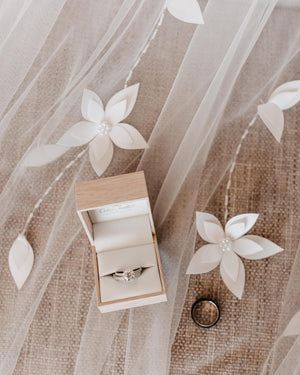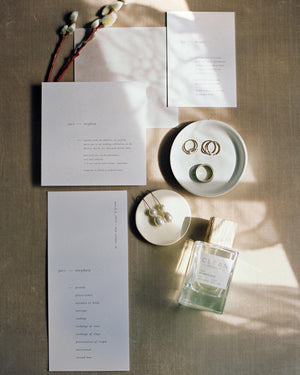You may also like
In our seven years of experience consulting and selling wedding veils online, we’ve observed that most brides typically purchase their veils between three to ten months prior to their wedding day, with some even starting their search a year in advance. Given the time and effort invested in selecting and crafting the perfect veil, it’s crucial to ensure it remains in pristine condition until the moment you walk down the aisle.
In this guide, Tara Bridal will walk you through the best methods to ensure your wedding dress and veil attire remains flawless until you say “I do.” From choosing the right storage space to specific packing techniques, here’s everything you need to know.

Bride: Alix Celestino - Ventura, CA, USA. Photo: karatillerphotography.com. Veil: Jesi
Choose the Right Space for Storing Your Wedding Dress and Veil
The environment where you store your wedding dress and veil plays a huge role in their condition leading up to the big day. Ideally, you’ll want to find a space that is cool, dry, and dark. A few key factors to consider include:
- Temperature Control: Keep the storage area at a consistent temperature to avoid excessive moisture or heat, which can damage delicate fabrics like lace, silk, or tulle.
- Humidity: High humidity levels can cause mold or mildew to develop, especially on natural fibers like silk. If you live in a particularly humid area, consider investing in a dehumidifier for the room where your gown and veil will be stored.
- Darkness: Prolonged exposure to sunlight can fade or discolor your dress and veil. Store them in a closet or a room with curtains drawn to minimize light exposure.
Preparing the Dress and Veil for Storage
Once you’ve found the right space, it’s time to prepare your dress and veil for storage. Proper preparation is crucial to ensure the gown maintains its original beauty.
Cleanliness is Key
Before you store your wedding dress, make sure it’s clean. Even if you’ve only tried it on briefly, oils from your skin, makeup, or sweat can cause stains to set over time. If your dress or veil has been handled multiple times, it’s a good idea to send them to a professional cleaner before storing them.
- Spot Check: Thoroughly inspect your dress and veil for any visible spots or stains that might need treatment.
- Dry Cleaning: Many fabrics used in wedding dresses and veils are delicate, so take them to a cleaner who specializes in wedding gowns. Make sure to ask about the types of chemicals they use, as harsh ones can damage certain fabrics.
After cleaning, let your dress and veil air out completely before storing. Storing them while damp can trap moisture, leading to odors or damage.
Invest in the Right Storage Materials
Using the correct storage materials can make all the difference when figuring out how to store a wedding dress and veil. Instead of just hanging your dress in your closet, opt for these storage solutions:
- Acid-Free Tissue Paper: Lay acid-free tissue paper between layers of fabric to prevent color transfer and keep the dress from developing creases. For your veil, gently fold it with layers of tissue paper in between.
- Garment Bag: Avoid plastic garment bags, as they can trap moisture, leading to mildew. Opt for a breathable muslin garment bag that protects the dress while allowing airflow. These bags also protect the fabric from dust and dirt.
- Hanger with Padding: If you need to hang your wedding dress, use a hanger with padding to avoid stretching or distorting the straps or bodice. For particularly heavy gowns, add reinforcement with a waist loop.

Hanging vs. Folding: Which is Best?
Knowing whether to hang or fold your dress and veil depends on the fabric, weight, and design of your attire. In general, lightweight fabrics like chiffon or tulle can be hung if needed, while heavier fabrics like satin or lace may require folding to avoid stretching.
Hanging Your Dress
Hanging a wedding dress can be a viable option for lightweight gowns, particularly those made from materials like silk, chiffon, or tulle. If you choose to hang your dress, follow these steps:
- Use a Sturdy Padded Hanger: Make sure the hanger is wide and padded to support the weight of the gown without creating tension on the fabric, preventing it from sagging.
- Cover the Dress: Always keep your gown protected by a breathable garment bag. Avoid plastic bags, which can cause discoloration or trap moisture.
- Watch Out for Dragging: Ensure the hem of the dress isn’t dragging on the ground. If your dress is too long for a standard closet, you may need to loop it over or fold it carefully.

Bride: Kelsey Loose - PA, USA. Veil: Julia
Folding Your Dress
For heavier gowns or dresses with delicate embellishments, folding is a better option. Follow these steps for safe folding:
- Place Acid-Free Tissue Paper: Layer the tissue paper between folds to prevent creasing and to avoid direct contact between fabric layers.
- Store in a Box: Use a large, sturdy box lined with acid-free paper. Make sure the box is wide enough so the dress can be folded gently without squeezing or bending it. Alternatively, as said before, you can use a breathable muslin garment bag.
- Avoid Crushing the Dress: Place the box in an area where it won’t be weighed down by other items. Crushing or overpacking the box can cause wrinkles and permanent creases.
For more information on storage options, check out our blog How to Preserve Your Wedding Dress for a Lifetime of Memories. It provides additional insights on how to choose the best preservation method for your special attire.
How to Store Your Veil
When learning how to store a wedding dress and veil, it’s easy to overlook the veil, but it requires just as much care. Whether your veil is short or cathedral-length, you’ll want to make sure it’s safely stored to prevent creases or damage.
Folding Your Veil
- Tissue Paper Between Folds: Just like your dress, use acid-free tissue paper between the layers of your veil to avoid creases.
- Roll for Long Veils: For very long veils, rolling rather than folding may help prevent harsh creases. Gently roll the veil around a soft piece of tissue paper to maintain its shape.
- Store Separately: Store your veil in its own garment bag or box to keep it from being tangled with your dress or other accessories. Avoid moisture, and exposure to direct sunlight.
Keep Away from Pets and Pests
It’s not just dirt and light that you need to protect your wedding dress and veil from—pests can also pose a risk. If you’re storing your attire for an extended period, make sure the area is free of bugs, moths, and pets.

Bride: Alix Celestino - Ventura, CA, USA. Photo: karatillerphotography.com. Veil: Jesi
- Use Moth Repellents: Natural repellents like cedar blocks or lavender sachets are a good choice to keep moths away. Avoid strong chemicals that might damage the fabric.
- Pet-Free Zone: Cats and dogs may be curious about new items, so keep your dress in an area they can’t access. A scratch or snag on your gown is not something you want to deal with days before your wedding, and no one wants to be removing fur from their veil.
Checking Your Dress and Veil Periodically
If you’re storing your bridal attire for several months or more, periodically check on it to ensure it remains in good condition. You don’t need to handle it too often, but an occasional check will help catch any issues before they become major problems.
- Look for Wrinkles: If you spot any wrinkles, you can lightly steam the dress or veil. However, avoid ironing, especially on delicate fabrics like silk or lace.
- Rehang or Refold: If you notice any areas of the dress or veil being stretched or crushed, adjust the way it’s hung or refold it in the storage box.
Transporting Your Dress and Veil
When it’s finally time to take your dress and veil to your venue, you’ll want to do so with the same care as when storing them. Always keep your dress in its garment bag and lay it flat in the car. For larger gowns, if this is not possible, consider hanging it from a hook inside the vehicle to avoid wrinkles or creases.
Conclusion
Knowing how to store a wedding dress and veil correctly will ensure that your attire remains flawless for your big day and beyond as a cherished keepsake. Proper care and maintenance of a wedding veil is just as crucial as preserving your dress. By choosing the right environment, using protective materials, and following specific storage techniques, you can keep both your dress and veil in pristine condition. A little extra care now will give you the peace of mind to focus on enjoying your wedding, knowing that when you step into your gown, it'll look just as perfect as the day you first fell in love with it.








